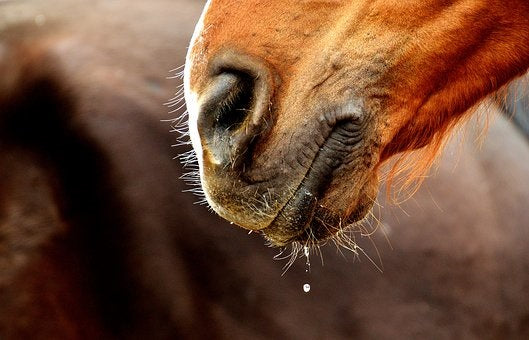
Nasal discharge in horses - one-sided or both-sided - white or yellow
Nasal discharge in horses – when does it become dangerous – causes and treatment
Nasal discharge in horses, also known as nasal mucus or "cold," can occur in various consistencies (from watery to thick), colors (clear, white, yellow, green, or even red if blood is present), and quantities. It can have many causes and indicate a number of different conditions, from harmless to serious. If the nasal discharge is caused by a disease, the causes can range from the digestive tract or Respiratory system go out.
Possible causes of nasal discharge in horses
- Too little exercise: Standing in a stable for too long is the most common cause of nasal discharge and is actually harmless. However, the lack of exercise causes too much mucus to accumulate in the lungs and sinuses, which can also lead to inflammation, so make sure your horse gets plenty of exercise.
- Respiratory tract infection : Viral or bacterial infections of the upper respiratory tract are a common cause. Examples include equine influenza or equine herpesvirus.
- Allergic reactions : Allergies to dust, pollen or mold spores can cause inflammation and nasal discharge.
- Dental diseases : Dental diseases can lead to abscesses or sinus infections that manifest as nasal discharge.
- Foreign body : A foreign body in the nose or sinuses can cause irritation and discharge.
- Chronic respiratory diseases : Diseases such as chronic obstructive bronchitis (COB) or hay asthma can be accompanied by nasal discharge.
- Injuries : Trauma to the head, e.g. from falls or blows, can lead to nasal discharge, especially if blood is present.
- Tumors : In rare cases, tumors in the nasal cavities or paranasal sinuses can cause discharge.
Assessment of nasal discharge
When evaluating nasal discharge, it is important to pay attention to color, consistency, and other symptoms:
- Clear and watery discharge is often less concerning and may indicate an allergic reaction or mild irritation.
- Yellow or green discharge usually indicates a bacterial infection.
- Nosebleeds (epistaxis) should always be examined by a veterinarian, as it may indicate a more serious condition.
Nasal discharge in horses – one-sided or both-sided
Nasal discharge in horses on one or both sides of a light, watery consistency is normal and occurs when the horse is being trained or is exercising independently. A healthy metabolism and lymphatic system is indicated by slight nasal discharge when the horse exerts itself.
Nasal discharge on one side – mucous
If your horse exhibits mucous nasal discharge from one side of his nose, alarm bells should ring. This could be a sign of serious illness. Inflammation of the air sac, the sinuses, or a foreign body can cause symptoms of one-sided nasal discharge. Dental problems or tumors could also be the cause. This should definitely be checked out by a trusted veterinarian.
Milky – cloudy nasal discharge in horses
If your horse exhibits a milky, cloudy or even white nasal discharge, you should always consider a respiratory disease. The good thing is that this color of the nasal discharge is a sign of the onset of the disease. Starting treatment at this time is optimal for a quick recovery. If other symptoms occur, such as fever or Cough You should definitely consult your veterinarian. White discharge can also be a sign of a chronic illness.
Yellow to green nasal discharge in horses
Dark yellow to greenish or purulent discharge indicates an infection. The upper respiratory tract: the sinuses and larynx, the lower respiratory tract: the lungs. Mucus production in horses is caused by various pathogens, bacteria, viruses, or fungal infections with associated inflammation. If this type of nasal discharge occurs, you should definitely consult a veterinarian.
Diagnosis of nasal discharge
Veterinarians use various diagnostic methods to determine the cause of nasal discharge:
- Clinical examination : Includes inspection of the nose, mouth and teeth, as well as palpation of the facial and jaw bones.
- Rhinoscopy : An endoscopic examination of the nose and paranasal sinuses for visual assessment.
- X-ray examination : This can be helpful to identify problems in the teeth, sinuses, or other bony structures.
- Blood test : A complete blood count and, if necessary, other specific tests can help detect inflammatory processes, infections, or other systemic problems.
- Smear and culture of nasal secretions : By culturing samples of nasal secretions, specific pathogens can be identified and appropriate antibiotics or medications can be selected.
- Allergy tests : If allergies are suspected, skin or blood tests can help determine the cause of the allergic reaction.
- Ultrasound examination : An ultrasound can provide clarifying insights, especially if dental disease or inflamed sinuses are suspected.
Treatment of nasal discharge
The treatment of nasal discharge in horses depends on the underlying cause:
- Infections can be treated with antimicrobial or antiviral medications, depending on the type of pathogen.
- Allergies are often treated with antihistamines or corticosteroids to minimize the inflammatory response.
- Dental diseases often require dental treatment or surgery to correct the cause.
- In the case of foreign bodies, removal under sedative or anesthetic conditions is necessary.
- In cases of chronic respiratory disease, management of the stable and the environment, along with drug therapy, may be necessary.
- Injuries can vary from simple wound treatments to surgical repairs.
Preventing nasal discharge in horses
- Regular dental examinations and care
- Vaccinations against common respiratory diseases
- Maintaining good stable hygiene and adequate ventilation
- Avoiding stress and excessive dust in the horse's environment
Any case of nasal discharge in horses should be taken seriously, especially if it occurs suddenly, is accompanied by other symptoms, or is prolonged. Early detection and treatment can not only improve the horse's well-being but also prevent long-term complications.
Long-term prognosis
The long-term prognosis for a horse with nasal discharge depends largely on the underlying cause. Many conditions are manageable with prompt diagnosis and appropriate treatment. Some chronic conditions require ongoing management strategies to keep the condition under control and maintain the horse's quality of life.
How can I help my horse with nasal discharge?
Prevention is the best approach, as a strong immune system helps strengthen your horse's defenses and protect him from many health problems.
We recommend supporting the respiratory tract with our specially developed herbal blend Bronchial Herbs Breathe Through for a natural boost to the respiratory tract and general well-being.
Source: Martina Hemm March 2025
Hand aufs Pferd/Hund Kräuter Manufaktur
Bronchial herbs for horses - Breathe through



